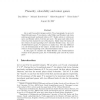Free Online Productivity Tools
i2Speak
i2Symbol
i2OCR
iTex2Img
iWeb2Print
iWeb2Shot
i2Type
iPdf2Split
iPdf2Merge
i2Bopomofo
i2Arabic
i2Style
i2Image
i2PDF
iLatex2Rtf
Sci2ools
85
Voted
SIAMDM
2008
2008
Planarity, Colorability, and Minor Games
Let m and b be positive integers and let F be a hypergraph. In an (m, b) Maker-Breaker game F two players, called Maker and Breaker, take turns selecting previously unclaimed vertices of F. Maker selects m vertices per move and Breaker selects b vertices per move. The game ends when every vertex has been claimed by one of the players. Maker wins if he claims all the vertices of some hyperedge of F; otherwise Breaker wins. An (m, b) Avoider-Enforcer game F is played in a similar way. The only difference is in the determination of the winner: Avoider loses if he claims all the vertices of some hyperedge of F; otherwise Enforcer loses. In this paper we consider the Maker-Breaker and Avoider-Enforcer versions of the planarity game, the k-colorability game and the Kt-minor game.
Game | Maker | Positive Integers | SIAMDM 2008 |
Related Content
| Added | 14 Dec 2010 |
| Updated | 14 Dec 2010 |
| Type | Journal |
| Year | 2008 |
| Where | SIAMDM |
| Authors | Dan Hefetz, Michael Krivelevich, Milos Stojakovic, Tibor Szabó |
Comments (0)

